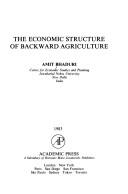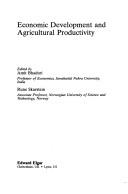| Listing 1 - 10 of 14 | << page >> |
Sort by
|

ISBN: 0120954206 Year: 1983 Publisher: London
Abstract | Keywords | Export | Availability | Bookmark
 Loading...
Loading...Choose an application
- Reference Manager
- EndNote
- RefWorks (Direct export to RefWorks)
Third World: economic development problems --- 631.15 --- 339.96 --- Agriculture --- -Farming --- Husbandry --- Industrial arts --- Life sciences --- Food supply --- Land use, Rural --- Farm production. Farm management. Farm administration --- Ontwikkelingshulp. Ontwikkelingssamenwerking. Ontwikkelingsproblematiek --- Economic aspects --- -631.15 --- -Farm production. Farm management. Farm administration --- 339.96 Ontwikkelingshulp. Ontwikkelingssamenwerking. Ontwikkelingsproblematiek --- 631.15 Farm production. Farm management. Farm administration --- -Third World: economic development problems --- -339.96 Ontwikkelingshulp. Ontwikkelingssamenwerking. Ontwikkelingsproblematiek --- Farming --- -Agriculture --- Developing countries: economic development problems
Book
ISBN: 0333291948 0333291956 9780333291955 9780333291948 Year: 1986 Publisher: Houndmills, Basingstoke, Hampshire: MacMillan,
Abstract | Keywords | Export | Availability | Bookmark
 Loading...
Loading...Choose an application
- Reference Manager
- EndNote
- RefWorks (Direct export to RefWorks)
Book
ISBN: 9811072094 9811072086 Year: 2018 Publisher: Singapore : Springer Singapore : Imprint: Springer,
Abstract | Keywords | Export | Availability | Bookmark
 Loading...
Loading...Choose an application
- Reference Manager
- EndNote
- RefWorks (Direct export to RefWorks)
This book is intended to serve as core text or handy reference on two key areas of metallic materials: (i) mechanical behavior and properties evaluated by mechanical testing; and (ii) different types of metal working or forming operations to produce useful shapes. The book consists of 16 chapters which are divided into two parts. The first part contains nine chapters which describe tension (including elastic stress – strain relation, relevant theory of plasticity, and strengthening methods), compression, hardness, bending, torsion – pure shear, impact loading, creep and stress rupture, fatigue, and fracture. The second part is composed of seven chapters and covers fundamentals of mechanical working, forging, rolling, extrusion, drawing of flat strip, round bar, and tube, deep drawing, and high-energy rate forming. The book comprises an exhaustive description of mechanical properties evaluated by testing of metals and metal working in sufficient depth and with reasonably wide coverage. The book is written in an easy-to-understand manner and includes many solved problems. More than 150 numerical problems and many multiple choice questions as exercise along with their answers have also been provided. The mathematical analyses are well elaborated without skipping any intermediate steps. Slab method of analysis or free-body equilibrium approach is used for the analytical treatment of mechanical working processes. For hot working processes, different frictional conditions (sliding, sticking and mixed sticking–sliding) have been considered to estimate the deformation loads. In addition to the slab method of analysis, this book also contains slip-line field theory, its application to the static system, and the steady state motion, Further, this book includes upper-bound theorem, and upper-bound solutions for indentation, compression, extrusion and strip drawing. The book can be used to teach graduate and undergraduate courses offered to students of mechanical, aerospace, production, manufacturing and metallurgical engineering disciplines. The book can also be used for metallurgists and practicing engineers in industry and development courses in the metallurgy and metallic manufacturing industries.
Materials science. --- Continuum mechanics. --- Industrial engineering. --- Engineering --- Metals. --- Materials Science. --- Metallic Materials. --- Operating Procedures, Materials Treatment. --- Continuum Mechanics and Mechanics of Materials. --- Materials Engineering. --- Materials. --- Structural control (Engineering). --- Manufactures. --- Mechanics. --- Mechanics, Applied. --- Manufacturing, Machines, Tools, Processes. --- Solid Mechanics. --- Engineering materials --- Industrial materials --- Engineering design --- Manufacturing processes --- Applied mechanics --- Engineering, Mechanical --- Engineering mathematics --- Classical mechanics --- Newtonian mechanics --- Physics --- Dynamics --- Quantum theory --- Manufactured goods --- Manufactured products --- Products --- Products, Manufactured --- Commercial products --- Manufacturing industries --- Materials --- Metals --- Alloys --- Mechanical properties. --- Engineering—Materials. --- Metallic elements --- Chemical elements --- Ores --- Metallurgy
Book
ISBN: 9780195680829 0195680820 Year: 2006 Publisher: New Delhi: Oxford university press,
Abstract | Keywords | Export | Availability | Bookmark
 Loading...
Loading...Choose an application
- Reference Manager
- EndNote
- RefWorks (Direct export to RefWorks)
Digital
ISBN: 9789811072093 Year: 2018 Publisher: Singapore Springer Singapore, Imprint: Springer
Abstract | Keywords | Export | Availability | Bookmark
 Loading...
Loading...Choose an application
- Reference Manager
- EndNote
- RefWorks (Direct export to RefWorks)
This book is intended to serve as core text or handy reference on two key areas of metallic materials: (i) mechanical behavior and properties evaluated by mechanical testing; and (ii) different types of metal working or forming operations to produce useful shapes. The book consists of 16 chapters which are divided into two parts. The first part contains nine chapters which describe tension (including elastic stress – strain relation, relevant theory of plasticity, and strengthening methods), compression, hardness, bending, torsion – pure shear, impact loading, creep and stress rupture, fatigue, and fracture. The second part is composed of seven chapters and covers fundamentals of mechanical working, forging, rolling, extrusion, drawing of flat strip, round bar, and tube, deep drawing, and high-energy rate forming. The book comprises an exhaustive description of mechanical properties evaluated by testing of metals and metal working in sufficient depth and with reasonably wide coverage. The book is written in an easy-to-understand manner and includes many solved problems. More than 150 numerical problems and many multiple choice questions as exercise along with their answers have also been provided. The mathematical analyses are well elaborated without skipping any intermediate steps. Slab method of analysis or free-body equilibrium approach is used for the analytical treatment of mechanical working processes. For hot working processes, different frictional conditions (sliding, sticking and mixed sticking–sliding) have been considered to estimate the deformation loads. In addition to the slab method of analysis, this book also contains slip-line field theory, its application to the static system, and the steady state motion, Further, this book includes upper-bound theorem, and upper-bound solutions for indentation, compression, extrusion and strip drawing. The book can be used to teach graduate and undergraduate courses offered to students of mechanical, aerospace, production, manufacturing and metallurgical engineering disciplines. The book can also be used for metallurgists and practicing engineers in industry and development courses in the metallurgy and metallic manufacturing industries.
Classical mechanics. Field theory --- Solid state physics --- Metals and their compounds --- Materials sciences --- Applied physical engineering --- Plant and equipment --- Production management --- legeringen --- materiaalkennis --- fabrieken --- toegepaste mechanica --- productie --- machines --- mechanica --- metalen
Book
Year: 1989 Publisher: Helsinki WIDER
Abstract | Keywords | Export | Availability | Bookmark
 Loading...
Loading...Choose an application
- Reference Manager
- EndNote
- RefWorks (Direct export to RefWorks)
Book
ISBN: 0873323599 Year: 1986 Publisher: Armonk Sharpe
Abstract | Keywords | Export | Availability | Bookmark
 Loading...
Loading...Choose an application
- Reference Manager
- EndNote
- RefWorks (Direct export to RefWorks)

ISBN: 185898615X Year: 1997 Publisher: Cheltenham : Elgar,
Abstract | Keywords | Export | Availability | Bookmark
 Loading...
Loading...Choose an application
- Reference Manager
- EndNote
- RefWorks (Direct export to RefWorks)
Agricultural productivity --- Agriculture --- Sustainable development --- Congresses. --- Economic aspects
Book
ISBN: 0140260056 9780140260052 Year: 1996 Publisher: New Delhi: Penguin books,
Abstract | Keywords | Export | Availability | Bookmark
 Loading...
Loading...Choose an application
- Reference Manager
- EndNote
- RefWorks (Direct export to RefWorks)
Book
ISBN: 0195628039 Year: 1993 Publisher: Delhi New York Oxford University Press
Abstract | Keywords | Export | Availability | Bookmark
 Loading...
Loading...Choose an application
- Reference Manager
- EndNote
- RefWorks (Direct export to RefWorks)
| Listing 1 - 10 of 14 | << page >> |
Sort by
|

 Search
Search Feedback
Feedback About UniCat
About UniCat  Help
Help News
News